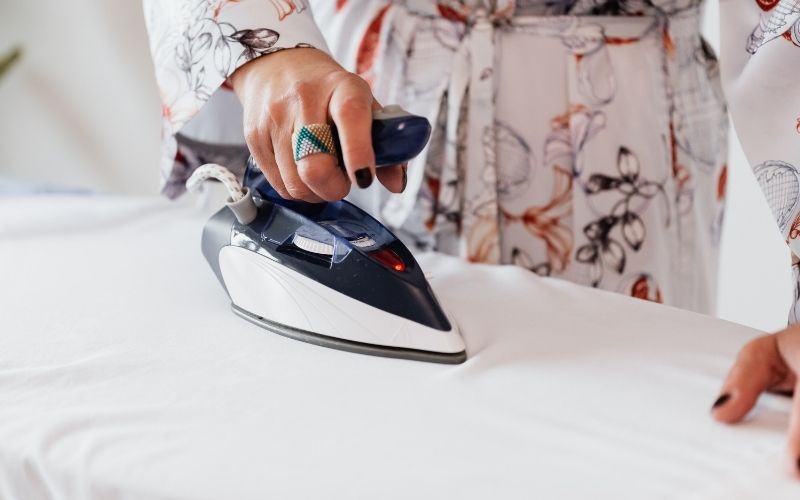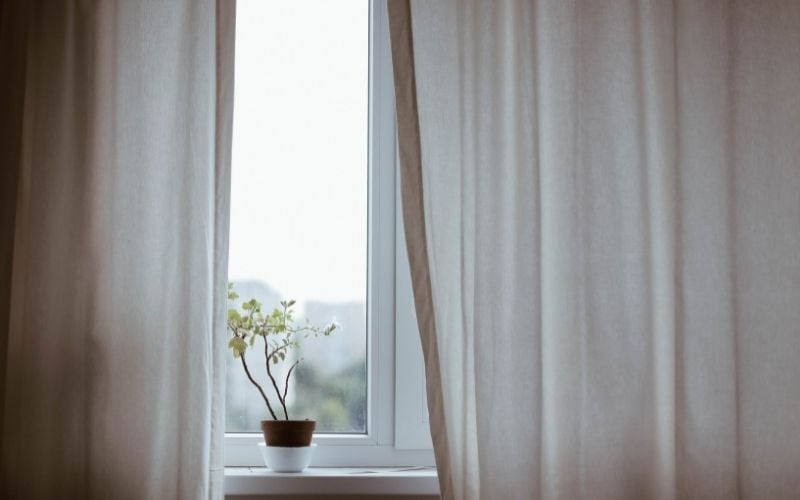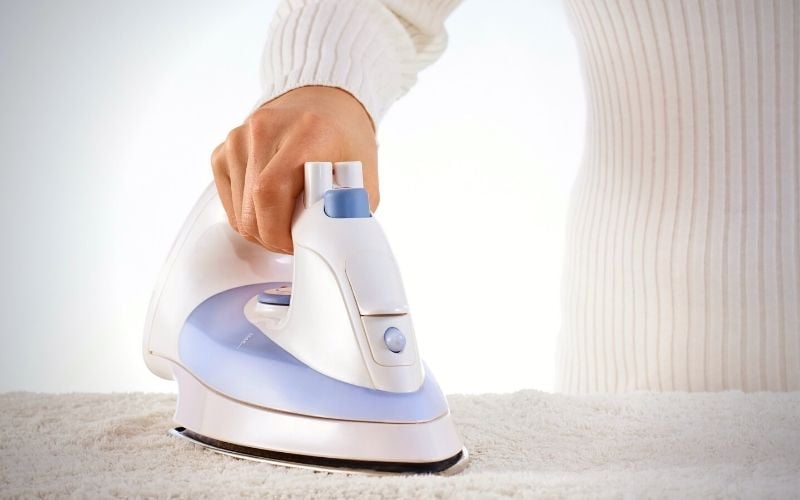Last Updated on March 26, 2023 by April

What is it about ironing that everyone hates? It’s one of those chores that many people like to ignore. And, when it comes to ironing curtains, well, most people could not be bothered. But listen here for the case on why you SHOULD iron curtains!
It may not be noticeable at first, but ironing your curtains instantly gives them a fresh and crisp look. If you aren’t impressed with your curtains, try this, and you just may be amazed at the before and after. Just like a newly ironed shirt, it takes the confidence level of a room way up.
Many don’t place ironing curtains high on their priority list. Consider adding it the next time you do a spring cleaning or other seasonal cleanups. And, if you have newly purchased curtains, it really helps to get rid of those rectangular-shaped crinkles from the packaging.
If you already have an iron, it won’t be much harder than ironing your clothes, there’s just a few key differences. So save some money on dry cleaning and learn how to properly iron curtains!
Different Fabrics While Ironing Curtains

Some curtains should not be ironed. Before you start ironing, be sure to check your tags and see if they have the iron sign or not. If they can’t be ironed, you’ll notice a big X over top of the iron. Instead, consider steaming the fabric.
When you don’t follow the instructions for a specific fabric, you risk ruining the curtains. Since we know how expensive curtains can be, we certainly don’t want to take that risk!
If you are unsure whether or not they can be ironed, start off with the lowest temperature and test on the inside seams. Typically, fabric blends should also always be at the lowest temperature.
Cotton
Set your iron to the highest heat. Cotton works best ironed while still damp. You can wash your curtains and let them dry a little before ironing or just pre-moisten the fabric with a spray bottle. Steam and spray the fabric while ironing as you see fit.
Linen
Linen also likes to be damp, so make sure the fabric is never dry. Pre-moisten the fabric. Flip your linen, so the opposite side of the fabric is directly touching the iron. Use high heat.
Silk
For silk, you want to set your iron to medium heat. Like linen, flip the fabric, so you’re ironing the inside panel instead.
Polyester
Iron while the fabric is still damp. Moisten as needed and use low heat to start, and medium if you need more oomph.
Nylon
Nylon will work best with low heat only. Don’t use any steam. Instead, use a spray bottle for any tough kinks in the fabric.
Acrylic
Iron on low heat and without steam on the opposite side of the fabric. Use a spray bottle if necessary.
Acetate
Same as acrylic, except avoid any kind of water.
Lace
To protect your lace pattern from squashing, place a layer of fabric between the curtain and the iron. Lace is best ironed while slightly damp and on a low setting.
Sheer Curtains
No matter the type of fabric, most sheer curtains won’t require ironing. If there are wrinkles, use a wrinkle release spray first. If that doesn’t work, iron according to the fabric.
Understanding Iron Settings Before Ironing Curtains

Before you jump right into ironing curtains, take some time to learn the language of your iron, so you don’t accidentally damage your fabric (or hurt yourself!). In the fabric instructions listed above, you will want to set your iron to either low, medium, or high.
While every iron has different settings, you can typically expect the following:
- 1-2 is low
- 3-5 is medium
- 6-7 is high
If you’re ironing multiple items, always start off with those that require the lowest settings. It can take a while for an iron to cool, and you want to make sure you don’t accidentally burn any fabric.
Add in water to your iron before you get started. Most irons will have a steamer button that releases steam whenever you press it to help get rid of wrinkles.
If you have one, use an ironing board. It is designed to protect the fabric and handle the heat of the iron. If you don’t have an ironing board, you can use a flat and stable surface such as a table or counter. To protect the surface from heat, lay down a thick towel and iron over the top of it.
How to Properly Iron Curtains
When it comes to ironing curtains, it won’t be too different than when you iron clothes. The major difference is the size of the fabric and preventing more wrinkles from popping up while you iron the other half of the fabric. Here is the best way to iron curtains to prevent more wrinkles from happening.
- Bring your iron to the window where your curtains hang. Raise your ironing board as high up as it will go.
- Remove your curtains from the curtain rod and line it up on the board, so you’re starting with the top first. Stretch the curtain and spread it out as much as you can.
- Fill your iron with water and set it to the ideal temperature for your curtains.
- Iron the top half of the curtains, pressing firmly down and releasing steam/spraying as needed for the fabric.
- Once the top half is done, hang them back up on the rod.
- The lower half will now be much easier to iron as the curtain rod helps to hold the fabric in place. Work your way down the curtains until the entire curtain is ironed and wrinkle-free.
Frequently Asked Questions about Ironing Curtains
Here are some questions I normally get when it comes to ironing curtains…
Can blackout curtains be ironed?
The main concern about ironing blackout curtains is melting the insulation. This can not only damage your curtains, but your iron as well if the fabric melts on them. Some curtains are now A-okay to be ironed, but others you want to be careful of. Always read the tag to double-check.
If you want to iron blackout curtains, cover your ironing board with aluminum foil. This will help to protect the foam insulation. Place your curtains on top of the foil with the insulation side facing down. Next, cover the top of the curtain with a bedsheet. This protects the top side of the curtain.
Set your iron to its lowest setting and use lots of steam while you iron the curtains. Whatever you do, do not iron directly on the insulated side. Once done, hang the curtains immediately to let them cool and prevent any new wrinkles from forming.
How do you iron hanging curtains?
If you don’t want to remove your curtains or it’s nearly impossible to do so, you can always iron just the bottom half as it hangs from the curtain. Most wrinkles form at the bottom, so this can help eliminate those specific crinkles.
However, if you want to remove wrinkles from the top of the curtain to the bottom while hanging, your best bet is to use a steamer. It may take a little longer, but it will be easier to work with for hanging curtains.
Are you supposed to iron curtains?
To each their own! It’s not necessary to iron curtains, but you certainly can if you notice they’re getting too wrinkly. It can make a huge difference in their appearance and even how they hang from the rod.
Ironing curtains is also extremely handy for new curtains that are having a hard time getting rid of the straight lines from the packaging. Most curtains will eventually drop these lines and hang in their preferred way, but this can take up to a month.
If you iron curtains, they will look great immediately. And then you can finally show off your redecorated living room to guests all complete!
How do you unwrinkle curtains without an iron?
If you don’t have an iron, there are a few more ways you can help to get rid of wrinkles in your curtains. The first, a fabric release spray, can help with mild wrinkles and those on the go.
A steamer iron on a low setting also works, especially if the curtains are still hanging. If you don’t have a steamer either, you can get the same effect using your shower. Hang your curtains in the bathroom, and then set the shower to its hottest setting. Close the door to the bathroom to seal in the steam and check in five minutes. Remove the curtains and turn off the shower once there are no more wrinkles.
But, if neither a steamer nor iron is recommended for the fabric, you may have to take them to a dry cleaner instead.
Is a steamer better than an iron?
When it comes to results, an iron will always work better than a steamer. Many don’t have a high enough hose to reach the top of the curtains, and you’ll find you’ll have to remove the curtains anyways if you were planning on saving time from ironing. Ironing does take longer and requires a little more skill, so steamers are still versatile and easy to use for those who don’t like to iron.
Supplies for Ironing Curtains
Steam Iron | Pur Steam Professional Grade Steam Iron

Handheld Steamer | Hilife Steamer for Clothes

Wrinkle Release Spray | Downy Wrinkle Releaser Fabric Spray



